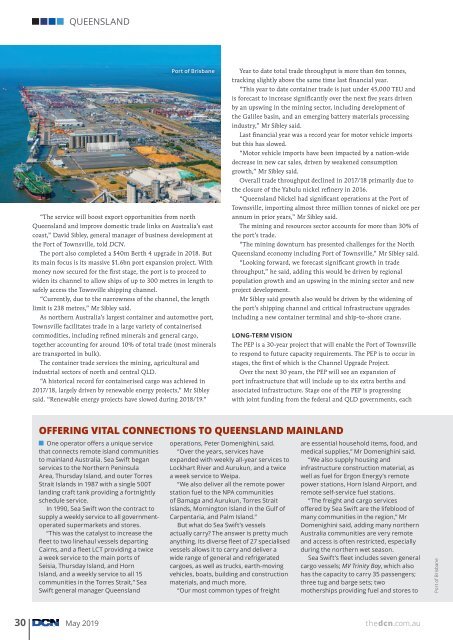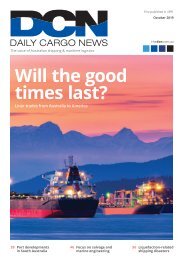DCN May Edition 2019
You also want an ePaper? Increase the reach of your titles
YUMPU automatically turns print PDFs into web optimized ePapers that Google loves.
QUEENSLAND<br />
Port of Brisbane<br />
“The service will boost export opportunities from north<br />
Queensland and improve domestic trade links on Australia’s east<br />
coast,” David Sibley, general manager of business development at<br />
the Port of Townsville, told <strong>DCN</strong>.<br />
The port also completed a $40m Berth 4 upgrade in 2018. But<br />
its main focus is its massive $1.6bn port expansion project. With<br />
money now secured for the first stage, the port is to proceed to<br />
widen its channel to allow ships of up to 300 metres in length to<br />
safely access the Townville shipping channel.<br />
“Currently, due to the narrowness of the channel, the length<br />
limit is 238 metres,” Mr Sibley said.<br />
As northern Australia’s largest container and automotive port,<br />
Townsville facilitates trade in a large variety of containerised<br />
commodities, including refined minerals and general cargo,<br />
together accounting for around 10% of total trade (most minerals<br />
are transported in bulk).<br />
The container trade services the mining, agricultural and<br />
industrial sectors of north and central QLD.<br />
“A historical record for containerised cargo was achieved in<br />
2017/18, largely driven by renewable energy projects,” Mr Sibley<br />
said. “Renewable energy projects have slowed during 2018/19.”<br />
Year to date total trade throughput is more than 6m tonnes,<br />
tracking slightly above the same time last financial year.<br />
“This year to date container trade is just under 45,000 TEU and<br />
is forecast to increase significantly over the next five years driven<br />
by an upswing in the mining sector, including development of<br />
the Galilee basin, and an emerging battery materials processing<br />
industry,” Mr Sibley said.<br />
Last financial year was a record year for motor vehicle imports<br />
but this has slowed.<br />
“Motor vehicle imports have been impacted by a nation-wide<br />
decrease in new car sales, driven by weakened consumption<br />
growth,” Mr Sibley said.<br />
Overall trade throughput declined in 2017/18 primarily due to<br />
the closure of the Yabulu nickel refinery in 2016.<br />
“Queensland Nickel had significant operations at the Port of<br />
Townsville, importing almost three million tonnes of nickel ore per<br />
annum in prior years,” Mr Sibley said.<br />
The mining and resources sector accounts for more than 30% of<br />
the port’s trade.<br />
“The mining downturn has presented challenges for the North<br />
Queensland economy including Port of Townsville,” Mr Sibley said.<br />
“Looking forward, we forecast significant growth in trade<br />
throughput,” he said, adding this would be driven by regional<br />
population growth and an upswing in the mining sector and new<br />
project development.<br />
Mr Sibley said growth also would be driven by the widening of<br />
the port’s shipping channel and critical infrastructure upgrades<br />
including a new container terminal and ship-to-shore crane.<br />
LONG-TERM VISION<br />
The PEP is a 30-year project that will enable the Port of Townsville<br />
to respond to future capacity requirements. The PEP is to occur in<br />
stages, the first of which is the Channel Upgrade Project.<br />
Over the next 30 years, the PEP will see an expansion of<br />
port infrastructure that will include up to six extra berths and<br />
associated infrastructure. Stage one of the PEP is progressing<br />
with joint funding from the federal and QLD governments, each<br />
OFFERING VITAL CONNECTIONS TO QUEENSLAND MAINLAND<br />
One operator offers a unique service<br />
that connects remote island communities<br />
to mainland Australia. Sea Swift began<br />
services to the Northern Peninsula<br />
Area, Thursday Island, and outer Torres<br />
Strait Islands in 1987 with a single 500T<br />
landing craft tank providing a fortnightly<br />
schedule service.<br />
In 1990, Sea Swift won the contract to<br />
supply a weekly service to all governmentoperated<br />
supermarkets and stores.<br />
“This was the catalyst to increase the<br />
fleet to two linehaul vessels departing<br />
Cairns, and a fleet LCT providing a twice<br />
a week service to the main ports of<br />
Seisia, Thursday Island, and Horn<br />
Island, and a weekly service to all 15<br />
communities in the Torres Strait,” Sea<br />
Swift general manager Queensland<br />
operations, Peter Domenighini, said.<br />
“Over the years, services have<br />
expanded with weekly all-year services to<br />
Lockhart River and Aurukun, and a twice<br />
a week service to Weipa.<br />
“We also deliver all the remote power<br />
station fuel to the NPA communities<br />
of Bamaga and Aurukun, Torres Strait<br />
Islands, Mornington Island in the Gulf of<br />
Carpentaria, and Palm Island.”<br />
But what do Sea Swift’s vessels<br />
actually carry? The answer is pretty much<br />
anything. Its diverse fleet of 27 specialised<br />
vessels allows it to carry and deliver a<br />
wide range of general and refrigerated<br />
cargoes, as well as trucks, earth-moving<br />
vehicles, boats, building and construction<br />
materials, and much more.<br />
“Our most common types of freight<br />
are essential household items, food, and<br />
medical supplies,” Mr Domenighini said.<br />
“We also supply housing and<br />
infrastructure construction material, as<br />
well as fuel for Ergon Energy’s remote<br />
power stations, Horn Island Airport, and<br />
remote self-service fuel stations.<br />
“The freight and cargo services<br />
offered by Sea Swift are the lifeblood of<br />
many communities in the region,” Mr<br />
Domenighini said, adding many northern<br />
Australia communities are very remote<br />
and access is often restricted, especially<br />
during the northern wet season.<br />
Sea Swift’s fleet includes seven general<br />
cargo vessels; MV Trinity Bay, which also<br />
has the capacity to carry 35 passengers;<br />
three tug and barge sets; two<br />
motherships providing fuel and stores to<br />
Port of Brisbane<br />
30 <strong>May</strong> <strong>2019</strong><br />
thedcn.com.au
















